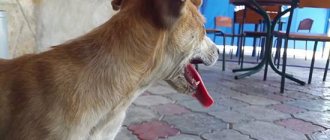Sometimes dog breeders turn to the veterinarian with a complaint that the dog choked on a bone or tried to swallow an inedible object. Due to the anatomical features of the nasal passages of mammals of the canine family, foreign objects very rarely get into their respiratory tract, while a bone, a lump of food or a small ball may well get stuck in a dog’s throat. This can cause suffocation or even death of the animal. In such cases, the life of the pet depends on your efficiency and adequacy of actions.
However, it often turns out that the dog’s owner does not know how to provide first aid or made a mistake with the diagnosis. Therefore, dog breeders should know the symptoms indicating that there is a foreign body in the animal’s pharynx, larynx or respiratory tract, and know what to do if such a dangerous situation arises.
Physiology of swallowing
Due to physiology, foreign bodies rarely enter the lungs. The larynx does not have its own protection; when swallowing, food particles or objects can get stuck in it. The act of swallowing in dogs is divided into three stages:
- Chewing food in the mouth. The process is controlled by consciousness; food (object) enters the oral cavity, where it is crushed into small pieces. It takes from a few seconds to minutes depending on the condition of the teeth.
- Direct swallowing. Controlled by a reflex arc. Triggered by irritation of the root of the tongue. The soft palate rises, blocking the communication between the pharynx and nasal cavity. This is why food cannot enter the respiratory system.
- Movement of the food ball. An involuntary reaction that occurs when the walls of the esophagus are irritated. As a result, food enters the stomach, where it is digested.
During any stage, the dog may choke and begin to cough up. Objects rarely get stuck in the esophagus or trachea - the pharynx has a limited size, which means that large, hard particles cannot travel further.
Possible causes of difficulty breathing
Coughing in dogs looks like signs of suffocation. It is a common symptom of many diseases, so it is important to distinguish between when a dog is coughing and when it is choking. Diseases accompanied by cough:
- Colds, rhinitis. With her, the dog makes sounds as if he was choking. It responds well to treatment, the acute form lasts up to several days.
- Kennel cough. The second name is adenoviral infection. It is characterized by a lingering dry cough caused by irritation of the upper respiratory tract. The temperature often rises.
- Allergy. Occurs upon contact with an irritant or food. She typically experiences difficulty breathing, which leads to collapse of the trachea. Accompanied by lacrimation, uncontrollable itching and redness of the skin.
- Heart failure. The animal periodically coughs during oxygen starvation - the enlarged heart puts pressure on the airways. The disease is more common in older dogs who are overweight.
Signs resembling suffocation can also occur with gastritis. When the disease worsens, vomiting occurs and the dog chokes on something.
Breeds with a short muzzle (brachycephalic) and small dogs can often choke. They may have a pathological structure of the palatal septum, which leads to blockage of the airways during eating. The problem is solved by surgical methods. Recovery must be careful; the dog can easily choke on the medicine.
Useful video
To learn what to do if your dog swallows a ball or chokes, watch this video:
Similar articles
- Stroke in a dog: first signs and symptoms, treatment...
All Obstetrics in dogs Internal diseases in dogs Infections and parasites Care and education Surgical diseases and injuries. ... Stroke is one of the most commonly diagnosed diseases in older dogs. Read more - Asthma in dogs: signs and symptoms, how to relieve an attack...
All Obstetrics in dogs Internal diseases in dogs Infections and parasites Care and education Surgical diseases and injuries. ... And here is more information about rhinitis in dogs and cats. Signs and symptoms of the disease. Read more
- Runny nose in a dog: causes in small breeds, how to cure...
All Obstetrics in dogs Internal diseases in dogs Infections and parasites Care and education Surgical diseases and injuries. ... You will learn about the causes of laryngitis in dogs, symptoms of the disease, methods of diagnosis and treatment. Read more
- Paralysis in dogs (sudden, hind legs, larynx)…
All Obstetrics in dogs Internal diseases in dogs Infections and parasites Care and education Surgical diseases and injuries. ... And here is more information about the treatment of spinal diseases in dogs. Read more
- A dog fell from a height: how dangerous is it, what to do if...
All Obstetrics in dogs Internal diseases in dogs Infections and parasites Care and education Surgical diseases and injuries. ... Brain damage often manifests itself in the form of a concussion - the dog grabs food, but chokes, cannot do ... Read more
Causes of suffocation
More often than not, dogs begin to choke after eating quickly. It is not uncommon for a dog to eat grass and choke. A large piece of food, large dry food or a fish bone can cause choking. Common reasons why a foreign body gets stuck in the throat:
- Rush. Eating food quickly. This feature occurs in large and medium-sized breeds, with irregular and large meals, and the owner’s haste.
- Greed. The dog snorts and swallows the food without chewing it first. As a rule, this is observed in animals after prolonged hunger, in the presence of competition - when several pets eat from the same bowl.
- Ingestion of a foreign body. A similar feature is characteristic of representatives of large breeds. Due to the large size of their mouth, they can swallow socks, a ball or a large bone.
- Gluing dry food. If you are in a hurry or if there is excessive salivation, the pieces may stick together into a lump, and your pet may choke on them.
Dogs should absolutely not be fed tubular (bird) bones or fish without preliminary cutting. Sharp pieces of bone can get stuck in the gums, throat, or puncture the stomach. Against this background, an infection develops, which can be fatal. There is a risk of internal bleeding and painful death of the pet.
Main signs of suffocation
When keeping a dog, you need to be able to distinguish a cough from a choking attack. Difficulty breathing can be identified by the following symptoms:
- the dog actively coughs and chokes;
- breathing becomes hoarse, the animal coughs;
- frequent vomiting occurs, which does not end with the release of masses. She barks like she's choking;
- the animal cannot swallow food, water or its own saliva (spits it);
- the head and neck are in a lowered position, the pet groans and does not respond to sounds;
- the dog cannot stand on its feet, falls and does not get up on its own, constantly coughs and loses consciousness;
- blue mucous membrane;
- anxiety and panic attacks, the animal tries to expel the foreign body and strongly rubs its neck with its paws.
External manifestations depend on the size of the dog and the characteristics of the stuck object. The most dangerous is the ingestion of sharp elements - they lead to damage to internal tissues, and there are patches of scarlet blood in the saliva. When large round objects enter the body, pain occurs on palpation of the esophagus and persistent changes in breathing.
Symptoms
• Cough • Shortness of breath • Cyanosis (bluish color of mucous membranes) • Weight loss • Lethargy • Poor appetite • Thirst • Frequent urination • Vomiting • DiarrheaWhen your dog is choking and you, not knowing what to do, look for advice on this topic on the Internet in forums , we recommend not to self-medicate or experiment on your beloved pet. The fact is that there are many reasons for an animal to suffocate, and the consequences of your experiment may disappoint you and your family.
[custom_ads_shortcode1]
Dog first aid technique
If you notice that your pet is wheezing, behavior has changed and vomiting is observed, you should take action as soon as possible. First of all, examine the oral cavity for the presence of a stuck foreign body. Start actively stroking your throat with your palm to relieve an attack of nausea (often a foreign object comes out with vomiting). If the dog choked and lost consciousness, perform resuscitation yourself.
Action algorithm:
- Place the dog on its right side on a flat surface, the floor.
- Inspect the oral cavity for the presence of foreign objects, lay your tongue along the jaw.
- Place your hands on your sternum and press until you hear the sound of air escaping.
- Repeat the manipulation until the animal’s natural breathing returns to normal.
For small dogs up to 16 kg, mouth-to-nose artificial respiration can be performed. To do this, place the dog on the right side, extend the tongue to the incisors. Close your mouth and begin to slowly inhale air into your nose until your chest rises slightly. Release the animal and let the air come out on its own. Repeat the manipulation at intervals of 3-5 seconds. The jaw must be closed during the process.
Help with swallowing sharp objects
If the cause of choking is swallowing a sharp object, it is important to induce the swallowing reflex. To do this, you can give a small piece of meat or bread crumb, or perform a manual throat massage. Emergency measures if there is no result:
- Firmly fix the dog's body, grab it with your hands by the skin between the ears.
- Pull back your lower jaw to expose your teeth.
- Examine the oral cavity using a flashlight.
- Remove the foreign object with your fingers or tweezers.
You cannot push the bone into the esophagus - this leads to mechanical damage to the tissue and death.
Help with swallowing round objects
If a dog is choking on a small ball, it should be pushed out of the larynx. To do this, feel for the object, press on it from the bottom, trying to push it up. Large pets can be helped in the following ways:
- Stand behind the dog, clasp the body with your hands at the junction of the abdomen and sternum.
- Press your body forward and upward.
- Repeat until the ball or ball comes out.
Photo: www.forgottothink.com
Usually 3-5 repetitions are enough. Small breeds should be held on your lap with their back pressed against their belly. Place your hand on your sternum and hold your head. Press firmly on the area, trying to move the object towards the larynx area.
Possible consequences of suffocation
If a foreign object becomes lodged in the larynx, there is a risk of swelling, which can be fatal. In addition, there is a possibility of intestinal obstruction, damage to internal organs and bleeding. Fish bones left in the mouth can cause gum disease and soft tissue infection. You should help your pet as soon as possible if he is choking on a bone.
If you can't help
If you cannot help at home, it is important to contact your veterinarian as soon as possible. Foreign objects are sometimes impossible to feel on your own; if they remain in the body for a long time, they cause serious problems. They can be detected by x-ray or ultrasound. In addition, only a veterinarian can prescribe medications to reduce inflammation, swelling and, if necessary, perform surgery. An emergency visit to the clinic can save your pet’s life, so you should not hesitate if he is choking on air, a bone or another object.
Prevention
The best way to prevent choking is to treat your dog like a small child. While it's almost impossible to stop them from putting something in their mouth, you should always be present and watch what they're chewing.
Avoid engorged chew toys or sticks and cut food into larger pieces. Do not give your dog trigeminal bones, which are known to cause choking when given to a dog.
Never give your dog a bone that fits completely in his mouth. Boiled bones are very dangerous because they can bend, be swallowed, and then form into a shape that causes blockage or damage.
Remove all bones and chew toys (including rawhides) as soon as they fit in your dog's mouth. Many dogs will try to swallow an object if it gets into their mouth.
What can you do to prevent your dog from choking?
There are several methods of prevention. Useful tips:
- take short breaks between meals, make the daily norm for 3-4 servings;
- during feeding, provide the dog with silence and comfort;
- use special bowls with dividers for dogs that quickly swallow food and cough;
- do not give uncut fish or bird bones;
- choose toys depending on the size of the mouth and the dog itself;
- remove small objects from the animal’s access area;
- pay attention to an animal that is burping or grunting with its nose.
It is important to know the phone number of the nearest veterinary clinic in order to save time searching for contacts in an emergency.
Precautionary measures
But every owner is recommended to leave their four-legged friend alone for long periods of time as little as possible. To eliminate the possibility of an accident at a moment when there is no one nearby who could provide assistance.
It is easier to prevent force majeure situations than to try to cope with negative consequences later. You should not feed your pet bones, especially tubular or fish bones. It is worth remembering that small objects pose a danger to the dog, as they can be swallowed by him. You should not give toys that he can chew or swallow parts of.
Briefly about the main thing
- Coughing due to structural features of the larynx or diseases is similar to suffocation. It is important to be able to determine the causes of an animal’s breathing problems.
- Dogs often dander when eating quickly or swallowing various objects. Provoking factors are haste, greed and dry food sticking together.
- Symptoms of suffocation are blue mucous membranes, difficulty breathing, nausea without vomiting, loss of consciousness.
- If the dog is choking, you need to check for foreign objects in the oral cavity and massage the larynx. If necessary, perform artificial respiration.
After barking
Problems with the respiratory system can cause the animal to exhibit unusual behavior after barking. The reason why a dog chokes after barking may be inflammatory processes - laryngitis, pharyngitis. Hypothermia, swimming in cold water during the hottest time of day, drinking cold water, low immunity are the main causes of colds.
Complication of the inflammatory process by pathogenic microorganisms leads to swelling of the larynx. Barking provokes overstrain of the ligaments, their filling with blood, which is accompanied by swelling and the dog tries to cough up.











